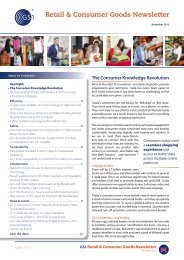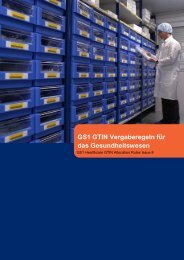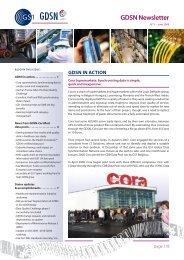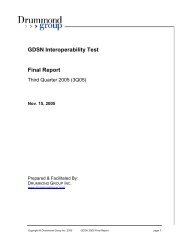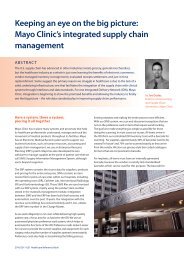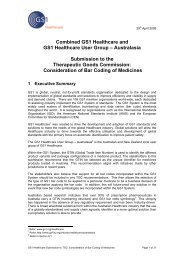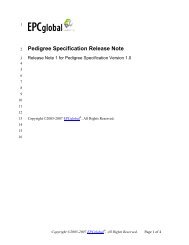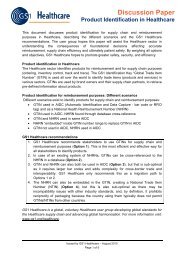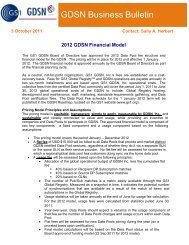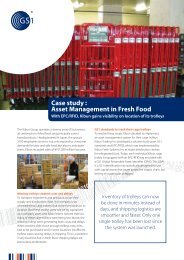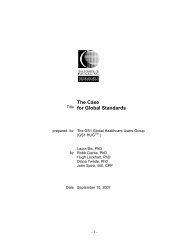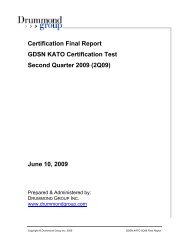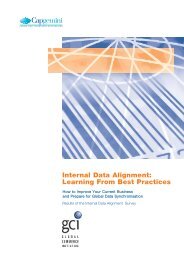The Application Level Events (ALE) Specification, Version 1.0 - GS1
The Application Level Events (ALE) Specification, Version 1.0 - GS1
The Application Level Events (ALE) Specification, Version 1.0 - GS1
Create successful ePaper yourself
Turn your PDF publications into a flip-book with our unique Google optimized e-Paper software.
EPC1<br />
EPC2<br />
EPC3<br />
EPC1<br />
EPC2<br />
EPC4<br />
EPC3<br />
EPC5<br />
EPC3<br />
EPC5<br />
EPC3<br />
EPC4<br />
EPC5<br />
EPC3<br />
EPC5<br />
EPC3<br />
EPC5<br />
Read Cycle 1<br />
Read Cycle 2 Read Cycle 3<br />
Read Cycle 4<br />
Read Cycle 5 Read Cycle 6<br />
Read Cycle 7<br />
Client 1 Event Cycle 1<br />
Client 2 Event Cycle 1<br />
Client 2 Event Cycle 2<br />
Client 3<br />
Event<br />
Cycle 1<br />
Report<br />
Report<br />
Report<br />
Report<br />
326<br />
327<br />
328<br />
329<br />
330<br />
331<br />
332<br />
333<br />
334<br />
335<br />
336<br />
337<br />
338<br />
339<br />
340<br />
341<br />
342<br />
343<br />
344<br />
345<br />
346<br />
347<br />
Report<br />
Report<br />
While the diagram shows read cycles arising from a single Reader, in practice a given<br />
event cycle may collect read cycles from more than one Reader. As the diagram<br />
suggests, there may be more than one active event cycle at any point in time. Multiple<br />
active event cycles may start and end with different read cycles, and may overlap in<br />
arbitrary ways. <strong>The</strong>y may gather data from the same Readers, from different Readers, or<br />
from arbitrarily overlapping sets of Readers. Multiple active event cycles could arise<br />
from one client making several simultaneous requests, or from independent clients. In all<br />
cases, however, the same read cycles are shared by all active event cycles that request<br />
data from a given Reader.<br />
<strong>The</strong> set of EPCs in a given read cycle from a given Reader is denoted by S. In the picture<br />
above, S1 = {EPC1, EPC2, EPC3} and S2 = {EPC1, EPC2, EPC4}.<br />
An event cycle is treated as a unit by clients, so clients do not see any of the internal<br />
structure of the event cycle. All that is relevant, therefore, is the complete set of EPCs<br />
occurring in any of the read cycles that make up the event cycle, from any of the Readers<br />
in the set specified for the event cycle, with duplicates removed. This is simply the union<br />
of the read cycle sets: E = S1 U S2 U …. In the example above for Client 1 Event<br />
Cycle 1 we have E1.1 = {EPC1, EPC2, EPC3, EPC4, EPC5}.<br />
Clients get information about event cycles through reports. A report is specified by a<br />
combination of these three parameters:<br />
• What set R to report, which may be<br />
• <strong>The</strong> complete set from the current event cycle R = Ecur; or<br />
Copyright © 2005, 2004 EPCglobal Inc, All Rights Reserved. Page 11 of 71



